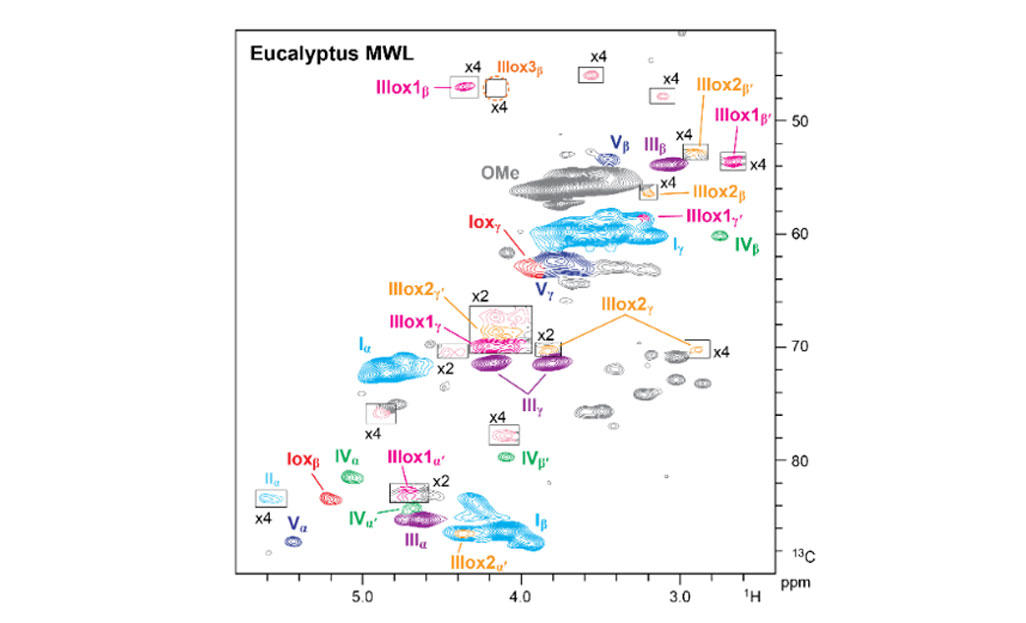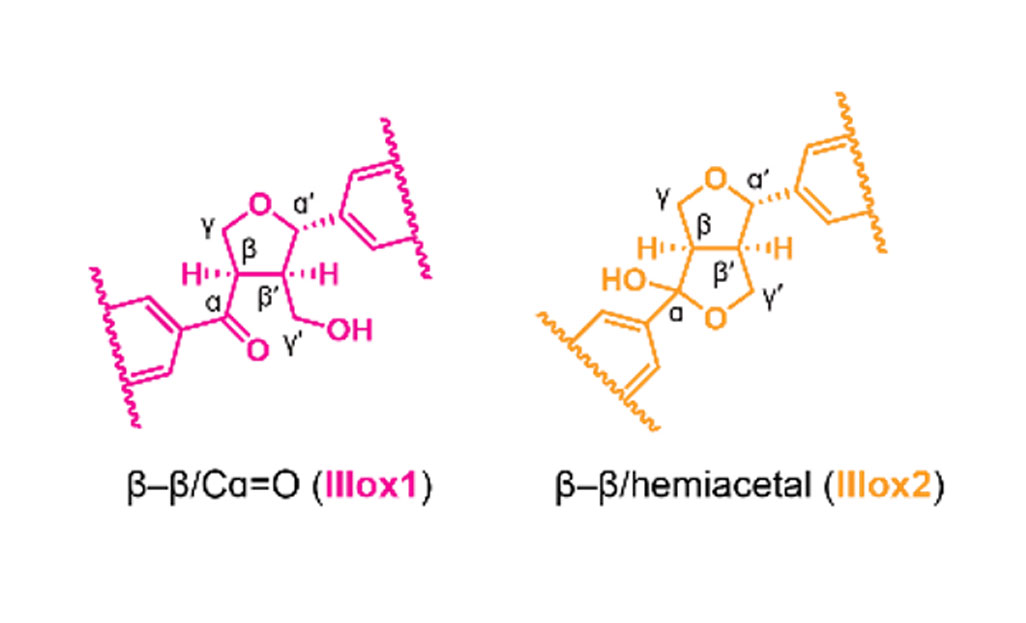京都大学 生存圏研究所
バイオマス変換分野
Laboratory of Biomass Conversion
Research Institute for Sustainable Humanosphere (RISH)
Kyoto University

京都大学 生存圏研究所
バイオマス変換分野
Laboratory of Biomass Conversion
Research Institute for Sustainable Humanosphere (RISH)
Kyoto University
地球温暖化の防止や、資源の有効利用の観点から、石油などの化石資源に依存しない循環型社会の実現が求められています。サステナブル(持続可能)な資源である木質バイオマスの細胞壁成分(セルロース、ヘミセルロース、リグニン)の精密な構造解析に基づき、木質バイオマスの成分分離や、化学変換・酵素変換などにより有用物質に変換する(バイオリファイナリー)ため、木材化学、有機化学、高分子科学、生化学などをベースにした研究を行っています。なかでも、細胞壁を固める成分であるリグニンに注目しています。リグニンはβ-O-4、β-5、β-β、β-1、4-O-5、5-5結合など、たくさんの結合様式があり、非常に複雑な構造をしています。このような非常に複雑なリグニンの構造が、実際にどのような構造をしていて、リグニンのモノマーがどのように重合してリグニンの骨格が組みあがっていくのか解明するため、関連の研究を続けています。さらに、細菌や木材腐朽菌などの微生物を用いた環境浄化に関する研究にも取り組んでいます。
From the viewpoint of prevention of global warming and effective use of resources, it is necessary to realize a recycling-oriented society that does not depend on fossil resources such as petroleum. Based on precise structural analysis of cell wall components (cellulose, hemicellulose, and lignin) of woody biomass, which is a sustainable resource, we conduct research based on wood chemistry, organic chemistry, polymer science, and biochemistry to separate components of woody biomass and convert them into useful substances by chemical and enzymatic conversion (biorefinery). Among them, we focus on lignin, a component that solidifies cell walls. Lignin has a very complex structure with many bonds, including β-O-4, β-5, β-β, β-1, 4-O-5, and 5-5 bonds. We continue related research to elucidate these extremely complex lignin structures and how the lignin monomers polymerize to assemble the lignin backbone. In addition, we are also engaged in research on environmental remediation using microorganisms such as bacteria and wood-decaying fungi.
リグニンの重合機構と化学構造の解明
Elucidation of polymerization mechanism and chemical structure of lignin
イオン液体を用いた細胞壁成分(セルロース・ヘミセルロース・リグニン)のHSQC NMR解析
HSQC NMR analysis of cell wall components (cellulose, hemicellulose, and lignin) using ionic liquids
人工リグニンポリマーの合成
Synthesis of Artificial Lignin Polymer
環境汚染の修復を目指した微生物の利用
Utilization of microorganisms for environmental pollution remediation
循環型社会を目指したリグニン研究と新素材創製
Lignin research and creation of new materials for a recycling-oriented society
当研究室の大学院生は、大学院農学研究科応用生命科学専攻木質バイオマス変換化学分野に所属しています。木材化学、有機化学、高分子科学、生化学など(これらに限定するわけではありません)を学んだ学生を募集しています。これまでに様々な大学・学部を卒業した学生が入学しています。研究室の見学を随時受け付けていますので、希望者は岸本まで連絡ください。
The graduate students in our laboratory belong to the Department of Wood Biomass Conversion Chemistry, Division of Applied Life Sciences, Graduate School of Agricultural Sciences. We are looking for students who have studied (but not limited to) wood chemistry, organic chemistry, polymer science, and biochemistry. Students who have graduated from various universities and faculties have been admitted to the program. Laboratory tours are always welcome, so please
contact Mr. Kishimoto if you are interested.
シリンギルリグニンの初期重合機構の解明
Elucidation of the initial polymerization mechanism of syringyl lignin
広葉樹リグニンの初期重合機構の解明を行うため、シリンギルリグニンのモノマーであるシナピルアルコールの酵素脱水素重合の際に、フローマイクロリアクター(FMR法)と過酸化水素の量を制限した滴下法を取り入れました。その結果、シリンギルリグニンの形成では、シナピルアルコールの二量化によりまずβ-β二量体が生成し、その後erythro選択的にβ-O-4構造で伸長することがわかりました。
To elucidate the initial polymerization mechanism of syringyl lignin, peroxidase-catalyzed dehydrogenative polymerization of sinapyl alcohol (SA), a syringyl lignin monomer, was conducted using a flow microreactor (FMR) method and the Zutropf (gradual addition of SA) method with limited amounts of H2O2. The results showed that dimerization of sinapyl alcohols first produces a β-β dimer, followed by erythro-selective formation of the β-O-4 structure in the syringyl lignin formation.
“Initial Stage of Syringyl Lignin Formation from Sinapyl Alcohol”
Yamaguchi, A.; Kishimoto, T.; Urabe, D.
J. Agric. Food Chem., 71(40), 14666-14677 (2023). DOI:10.1021/acs.jafc.3c03402
広葉樹リグニンの新規部分構造の発見
Discovery of a New Substructure of Hardwood Lignin
広葉樹リグニンのモノマーであるシナピルアルコールを、ラッカーゼを用いて脱水素重合すると、α-カルボニル型β-β二量体(IIIox1)とそのヘミアセタール型二量体(IIIox2)が生成することが分かりました。さらに、これらの部分構造が、ユーカリやアカシアなどの広葉樹リグニン中に存在することを新たに見いだしました。これらのα-カルボニル構造は細胞壁中でのリグニンの重合反応により生成すると考えられます。
Dehydrogenative polymerization of sinapyl alcohol, a hardwood lignin monomer, with laccase has been found to produce dimers with α-carbonyl β-β structure (IIIox1) and its hemiacetal structure (IIIox2). Furthermore, we found that these substructures exist in hardwood lignins such as Eucalyptus and Acacia. These α-carbonyl structures are thought to be generated by the polymerization reaction of lignin in the cell wall.
“Existence of Syringyl α-Carbonyl-Type Tetrahydrofuran β–β Structure in Hardwood Lignins”
Takao Kishimoto, Ayumi Hiyama, Ayana Yamashita, Toshiyuki Takano, Yuki Tobimatsu, Daisuke Urabe,
ACS Sustainable Chemistry & Engineering, 10(37) 12394-12401 (2022). DOI: 10.1021/acssuschemeng.2c03861

